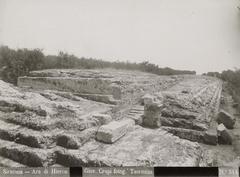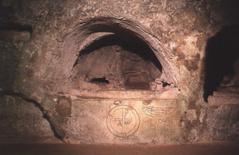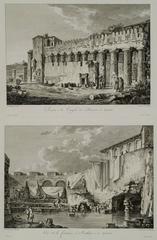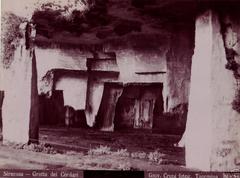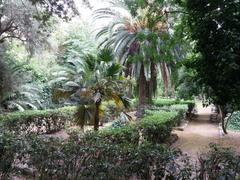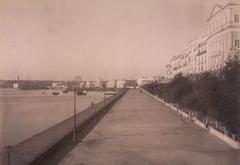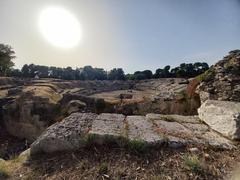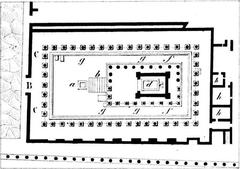Guide to Visiting Area Monumentale della Neapolis, Syracuse, Italy
Date: 18/07/2024
Introduction
The Area Monumentale della Neapolis in Syracuse, Italy, is a remarkable archaeological park that serves as a window into the ancient world. This site, rich with Greek, Roman, and Byzantine history, offers visitors a unique opportunity to explore some of the most well-preserved structures from antiquity. Founded by Greek settlers from Corinth in 734 BC, Syracuse quickly became one of the most influential cities in the ancient world. The development of the Neapolis, or ‘New City,’ in the 5th century BC marked the city’s expansion and the establishment of its public and cultural heart (UNESCO) (Ancient History Encyclopedia).
The Greek period saw the construction of the Greek Theatre, a marvel of ancient engineering that could accommodate up to 15,000 spectators. This theatre, along with other structures like the Roman Amphitheatre and the Ear of Dionysius, highlights the advanced architectural and cultural achievements of the time. The Roman conquest in 212 BC introduced new buildings and modifications to existing ones, further enriching the site’s historical tapestry (Britannica).
Following the fall of the Western Roman Empire, Syracuse came under Byzantine control, and although the focus shifted to the island of Ortygia, the Neapolis area continued to be of significance. The modern rediscovery of this site in the 19th century has transformed it into a major archaeological park, attracting scholars and tourists alike who come to marvel at its monuments and delve into its rich history (Italy This Way).
Table of Contents
- Introduction
- Ancient Origins
- Key Monuments and Structures
- Visiting the Area Monumentale della Neapolis
- Preservation and Tourism
- FAQ
- Conclusion
Ancient Origins
The Area Monumentale della Neapolis, located in Syracuse, Italy, is a testament to the city’s rich and varied history. Syracuse was founded by Greek settlers from Corinth in 734 BC, and it quickly grew into one of the most powerful and influential cities in the ancient world. The Neapolis, or “New City,” was developed during the 5th century BC as part of the city’s expansion. This area became the heart of Syracuse’s public and cultural life, housing some of the most significant monuments and structures of the time.
Greek Period
During the Greek period, Syracuse was a major center of political and military power. The Neapolis area was home to several important structures, including the Greek Theatre, one of the largest and best-preserved ancient theaters in the world. Built in the 5th century BC, the theatre could accommodate up to 15,000 spectators and was used for dramatic performances, political gatherings, and public events. The theatre’s design, with its excellent acoustics and panoramic views, reflects the advanced engineering skills of the ancient Greeks (Ancient History Encyclopedia).
Roman Era
The Roman conquest of Syracuse in 212 BC marked a new chapter in the history of the Neapolis. The Romans recognized the strategic and cultural importance of Syracuse and invested in the development of the city. They expanded and modified many of the existing Greek structures, including the Greek Theatre, which continued to be used for performances and public spectacles. The Romans also constructed new buildings, such as the Roman Amphitheatre, which was used for gladiatorial games and other forms of entertainment (Britannica).
Byzantine and Medieval Periods
Following the fall of the Western Roman Empire, Syracuse came under Byzantine control in the 6th century AD. During this period, the city continued to be an important administrative and military center. The Neapolis area, however, saw a decline in its prominence as the focus of the city shifted to the fortified island of Ortygia. Despite this, some of the ancient structures in the Neapolis were repurposed and continued to be used. For example, the Greek Theatre was adapted for use as a quarry, with its stones being used in the construction of new buildings (Italy This Way).
Modern Rediscovery
The modern rediscovery and excavation of the Area Monumentale della Neapolis began in the 19th century. Archaeologists and historians recognized the significance of the site and undertook extensive efforts to uncover and preserve its ancient structures. Today, the Neapolis is a major archaeological park, attracting visitors from around the world who come to explore its rich history and marvel at its well-preserved monuments.
Key Monuments and Structures
Greek Theatre
The Greek Theatre is undoubtedly the most iconic structure in the Neapolis. Its large, semi-circular design and excellent state of preservation make it a highlight for visitors. The theatre’s construction involved carving the seating area directly into the hillside, a technique that not only provided stability but also enhanced the acoustics. The theatre was used for various purposes, including dramatic performances, political meetings, and public ceremonies. Its significance is underscored by the fact that it continued to be used and modified during the Roman period (Italy Guides).
Roman Amphitheatre
The Roman Amphitheatre, built in the 3rd century AD, is another major attraction in the Neapolis. Unlike the Greek Theatre, the amphitheatre was designed for more violent forms of entertainment, such as gladiatorial games and animal hunts. The structure is elliptical in shape, with a central arena surrounded by tiered seating. The amphitheatre could accommodate thousands of spectators, reflecting the popularity of these events in Roman society. Today, visitors can explore the remains of the amphitheatre and imagine the spectacles that once took place there (Sicily).
Ear of Dionysius
The Ear of Dionysius is a unique and fascinating feature of the Neapolis. This artificial limestone cave, named by the painter Caravaggio in the 16th century, is renowned for its exceptional acoustics. According to legend, the cave was used by the tyrant Dionysius I to eavesdrop on prisoners due to its ability to amplify sound. The cave is approximately 23 meters high and 65 meters deep, with a distinctive S-shaped curve that enhances its acoustic properties. Visitors to the Neapolis can enter the cave and experience its remarkable sound effects firsthand (Atlas Obscura).
Altar of Hieron II
The Altar of Hieron II is a massive sacrificial altar built in the 3rd century BCE by the tyrant Hieron II. Measuring 198 meters in length and 22.8 meters in width, it is one of the largest altars from the ancient world. The altar was used for large-scale animal sacrifices during public festivals, particularly in honor of Zeus. Although much of the structure has been dismantled over the centuries, its sheer size and historical significance make it a noteworthy site within the park (Sicily).
Latomia del Paradiso
The Latomia del Paradiso is one of the ancient stone quarries that provided the material for many of Syracuse’s buildings and monuments. These quarries, dating back to the 6th century BCE, are now lush gardens filled with citrus trees, oleanders, and other Mediterranean flora. The quarries also contain several caves, including the Ear of Dionysius. The Latomia del Paradiso offers a serene and picturesque environment, contrasting with its historical use as a labor-intensive quarry (Italy Guides).
Grotta dei Cordari
The Grotta dei Cordari, or Rope-makers’ Cave, is another notable cave within the Latomia del Paradiso. This cave was historically used by rope-makers, who took advantage of its constant humidity to keep their materials pliable. The cave features a series of columns and arches carved out of the limestone, creating a labyrinthine interior. Visitors can explore the cave and imagine the daily life of the artisans who once worked there (Sicily).
Necropolis of Grotticelle
The Necropolis of Grotticelle is an ancient burial site located within the Neapolis Archaeological Park. This necropolis contains numerous rock-cut tombs dating from the Greek and Roman periods. Among the most famous tombs is the so-called “Tomb of Archimedes,” although its association with the famous mathematician is debated. The necropolis provides valuable insights into the funerary practices and beliefs of ancient Syracuse’s inhabitants (Italy Guides).
Visiting the Area Monumentale della Neapolis
Visiting Hours and Tickets
The Area Monumentale della Neapolis is open daily from 9:00 AM to 7:00 PM. Tickets can be purchased at the entrance or online through the official website. General admission is €10 for adults, €5 for students and seniors, and free for children under 12.
Travel Tips and Nearby Attractions
When visiting Syracuse, consider exploring nearby attractions such as the Island of Ortygia, the Syracuse Archaeological Museum, and the Catacombs of San Giovanni. Plan your trip to include these sites for a comprehensive historical experience.
Accessibility
The archaeological park is equipped with facilities to accommodate visitors with disabilities, including well-maintained pathways and accessibility options.
Preservation and Tourism
The preservation of the Area Monumentale della Neapolis is a priority for both local authorities and international organizations. Efforts are ongoing to protect and maintain the site’s ancient structures, ensuring that they can be enjoyed by future generations. The Neapolis is a popular tourist destination, attracting visitors from around the world who come to explore its rich history and cultural heritage. Guided tours, informational panels, and multimedia presentations help to enhance the visitor experience, providing insights into the significance of the site’s monuments and their historical context (UNESCO).
FAQ
What are the visiting hours for the Area Monumentale della Neapolis?
- The park is open daily from 9:00 AM to 7:00 PM.
How much do tickets cost?
- General admission is €10 for adults, €5 for students and seniors, and free for children under 12.
Are there guided tours available?
- Yes, guided tours are available and can be booked in advance through the official website.
Is the site accessible for visitors with disabilities?
- Yes, the site has facilities to accommodate visitors with disabilities, including well-maintained pathways and accessibility options.
Conclusion
The Area Monumentale della Neapolis in Syracuse, Italy, is a site of immense historical and cultural significance. Its ancient structures, including the Greek Theatre, Roman Amphitheatre, and Ear of Dionysius, offer a glimpse into the rich and varied history of Syracuse. The ongoing efforts to preserve and promote the site ensure that it remains a valuable resource for both scholars and tourists, providing a unique window into the past. Stay up to date with the latest information by visiting the official website or following on social media.
References
- UNESCO. (n.d.). Syracuse and the Rocky Necropolis of Pantalica. Retrieved from https://whc.unesco.org/en/list/1200/
- Ancient History Encyclopedia. (n.d.). Syracuse. Retrieved from https://www.ancient.eu/Syracuse/
- Britannica. (n.d.). Syracuse, Italy. Retrieved from https://www.britannica.com/place/Syracuse-Italy
- Italy This Way. (n.d.). Syracuse. Retrieved from https://www.italythisway.com/places/syracuse.php
- Italy Guides. (n.d.). Greek Theatre. Retrieved from https://www.italyguides.it/en/sicily/syracuse/greek-theatre
